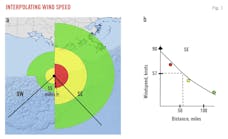BP: Macondo sheen likely coming from oil droplets on cofferdam
BP PLC on Oct. 18 confirmed the integrity of the sealed deepwater Macondo well and its associated relief wells following an extensive subsea survey using a remotely operated vehicle to identify potential sources of a surface sheen near Mississippi Canyon Block 252 off Louisiana.
An inspection that took nearly 3 days identified a cofferdam—a piece of containment equipment used during the Deepwater Horizon response—as the probable source of the surface sheen.
Transocean Ltd. owned the Deepwater Horizon semisubmersible, which sank after an explosion and fire associated with an Apr. 20, 2010, blowout. Eleven people aboard the semi were killed. The Deepwater Horizon drilled the Macondo well for BP and its partners.
The cofferdam is a 86-ton steel container that was lowered over a leaking drill pipe at the Macondo well site in May 2010 in an attempt to capture the oil and funnel it to the surface. A mixture of oil and slushy methane hydrates was trapped inside the cofferdam during the response.
Earlier this month, the US Coast Guard confirmed samples collected from a recent oil sheen matched samples of oil that originated from the deepwater Macondo well blowout and resulting 2010 oil spill (OGJ Online, Oct. 11, 2012).
BP said the latest survey marked the third time since the Macondo well was permanently sealed in September 2010 that it has been visually inspected at the sea floor and confirmed not to be leaking.
The latest survey was conducted jointly by BP and Transocean with USCG oversight. It was also performed in the presence of the Federal On-Scene Coordinator for the Deepwater Horizon oil spill, as well as representatives from the Interior Department’s Bureau of Safety and Environmental Enforcement, Bureau of Ocean Energy Management, and state on-scene coordinators from Louisiana, Mississippi, and Florida.
On Oct. 17, ROV video inspection observed small, intermittent drops of oil coming from an opening at the top and another on one side of the cofferdam. Samples of the droplets were collected from the opening at the top, known as the stovepipe, and will be analyzed to confirm a match with the sheen. Droplets also were observed coming out of a small connection port on one side of the cofferdam.
The USCG has determined the sheen is not feasible to recover and does not pose a risk to the shoreline.
The entire length of the 4,500-ft riser was visually inspected, with separate passes made for the top and two sides, and no oil was seen leaking.
The Macondo well was capped on Jul. 15, 2010, and permanently sealed with cement on Sept. 19, 2010. The well was later plugged and abandoned with the approval and oversight of the US government. Well integrity was confirmed during and after the abandonment process.
Contact Paula Dittrick at [email protected].
